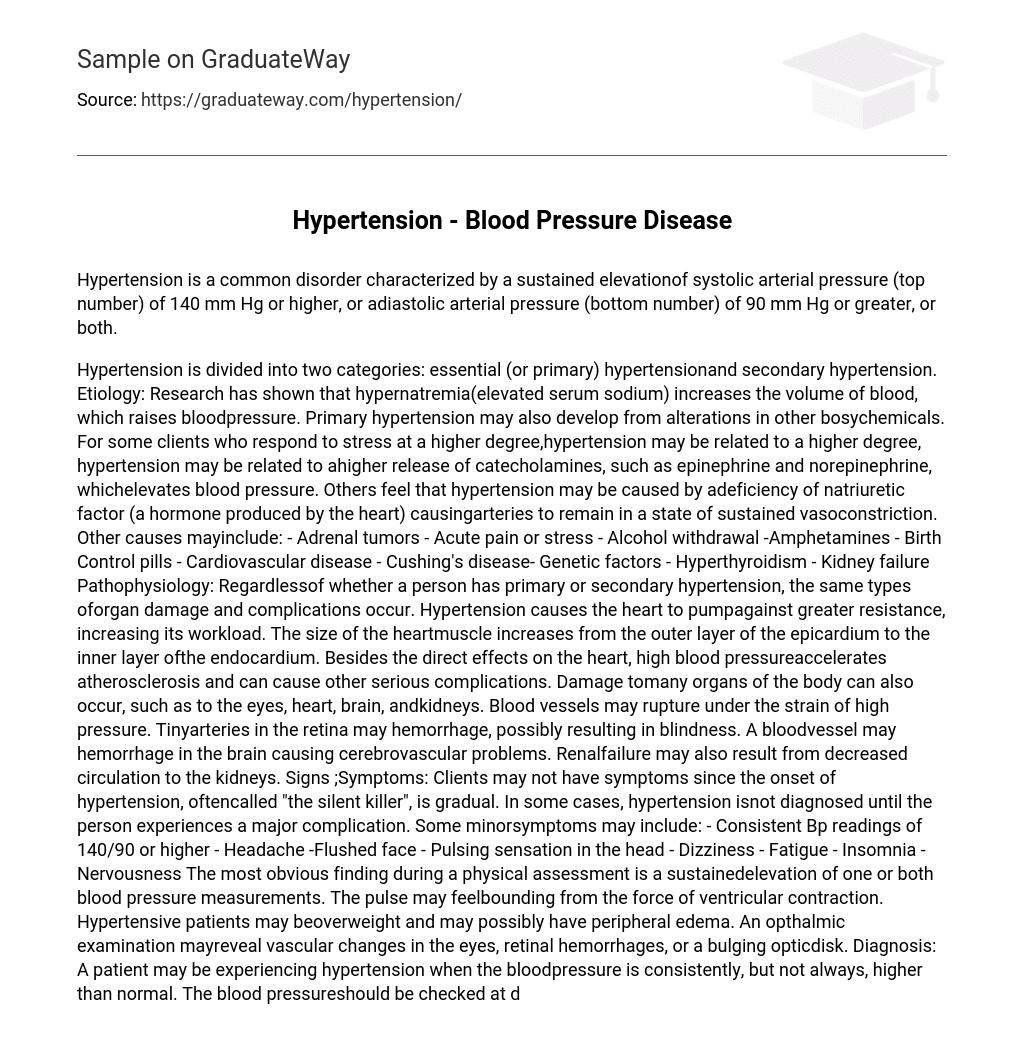Hypertension is a common disorder characterized by a sustained elevationof systolic arterial pressure (top number) of 140 mm Hg or higher, or adiastolic arterial pressure (bottom number) of 90 mm Hg or greater, or both.
Hypertension is divided into two categories: essential (or primary) hypertensionand secondary hypertension. Etiology: Research has shown that hypernatremia(elevated serum sodium) increases the volume of blood, which raises bloodpressure. Primary hypertension may also develop from alterations in other bosychemicals.
For some clients who respond to stress at a higher degree,hypertension may be related to a higher degree, hypertension may be related to ahigher release of catecholamines, such as epinephrine and norepinephrine, whichelevates blood pressure. Others feel that hypertension may be caused by adeficiency of natriuretic factor (a hormone produced by the heart) causingarteries to remain in a state of sustained vasoconstriction.
Other causes mayinclude:
- Adrenal tumors
- Acute pain or stress
- Alcohol withdrawal
- Amphetamines
- Birth Control pills
- Cardiovascular disease
- Cushing’s disease
- Genetic factors
- Hyperthyroidism
Kidney failure Pathophysiology: Regardlessof whether a person has primary or secondary hypertension, the same types oforgan damage and complications occur. Hypertension causes the heart to pumpagainst greater resistance, increasing its workload. The size of the heartmuscle increases from the outer layer of the epicardium to the inner layer ofthe endocardium. Besides the direct effects on the heart, high blood pressureaccelerates atherosclerosis and can cause other serious complications.
Damage tomany organs of the body can also occur, such as to the eyes, heart, brain, andkidneys. Blood vessels may rupture under the strain of high pressure. Tinyarteries in the retina may hemorrhage, possibly resulting in blindness. A bloodvessel may hemorrhage in the brain causing cerebrovascular problems. Renalfailure may also result from decreased circulation to the kidneys. Signs ;Symptoms: Clients may not have symptoms since the onset of hypertension, oftencalled “the silent killer”, is gradual.
Medical Treatment: Currently thereis no cure for hypertension that is not secondary to another disease orcondition. However, there are successful treatments that do control the effectsof the hypertension. Initial management of hypertension depends on the degree ofpressure elevation. Mild elevation may be treatable with nonpharmacologictherapy, which may include rest, reduction of stress, counseling, weight loss,reduction of sodium in the diet, limiting the drinking of alcohol and theelimination of smoking tobacco products.
If cholesterol and triglyceride levelsare increased, a diet low in saturated fats may be recommended. Depending on theclients response to nonpharmacologic therapy, one of several antihypertensivedrugs may be prescribed. There are many different types of drugs with proventrack records in the control of hypertension, such as Apresoline and Brodipine. Choice of treatment depends upon the patient’s age, race, and medical history.
Prognosis: If untreated, hypertension places a patient at high risk for thedevelopment of a disabling or fatal disease. Thorough evaluation by a medicaldoctor will start a patient on a successful treatment program that will includepatient education for a healthier lifestyle. Following the recommended treatmentprogram will enable the patient to enjoy a more active life.





